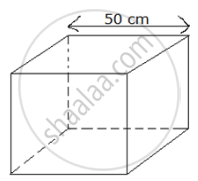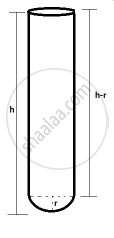Advertisements
Advertisements
Question
A tin maker converts a cubical metallic box into 10 cylindrical tins. The side of the cube is 50 cm and the radius of the cylinder is 7 cm. Find the height of each cylinder so made, if the wastage of 12% is incurred in the process `(pi = 22/7)`
Solution


Side of cube = a = 50 cm
Volume of cube = V = a3 = 503 = 125000 cm3
Radius of cylinder = r = 7 cm
Height of cylinder = h cm
Volume of cylinder = πr2h
= (22/7) × 72 × h
= 154h cm3
10 cylinder tins are made
Total volume of cylinders = 10 × 154h
= 1540h cm3
Wastage of 12% of the volume of cube therefore 88% of the volume is utilized
`88/100 xx 125000 = 1250 xx 88 = 110000`cm3
Hence 110000 cm3 of cube volume is utilized to make 10 tins
Volume remains unchanged
∴ the volume of cube utilized = Total volume of cylinders
∴ 110000 = 1540h
∴ 11000 = 154h
∴ h = 11000/154
∴ h = 71.428 cm
Height of cylinder = 71.428 cm
APPEARS IN
RELATED QUESTIONS
Water flows at the rate of 15 m per minute through a cylindrical pipe, having the diameter 20 mm. How much time will it take to fill a conical vessel of base diameter 40 cm and depth 45 cm?
A test tube has diameter 20 mm and height is 15 cm. The lower portion is a hemisphere. Find the capacity of the test tube. (π = 3.14)

A farmer connects a pipe of internal diameter 20 cm from a canal into a cylindrical tank which is 10 m in diameter and 2 m deep. If the water flows through the pipe at the rate of 4 km per hour, in how much time will the tank be filled completely?
The dimensions of a cuboid are 44 cm, 21 cm, 12 cm. It is melted and a cone of height 24 cm is made. Find the radius of its base.

Observe the measures of pots In the given figure. How many jugs of water can the cylindrical pot hold?
A cylindrical bucket of diameter 28 cm and a height of 20 cm was full of sand. When the sand in the bucket was poured on the ground, the sand got converted into a shape of a cone. If the height of the cone was 14 cm, what was the base area of the cone?
A vessel is in the form of a hemispherical bowl mounted by a hollow cylinder. The diameter is 14 cm and the height of the vessel is 13 cm. Find the capacity of the vessel
From a solid cylinder whose height is 2.4 cm and the diameter 1.4 cm, a cone of the same height and same diameter is carved out. Find the volume of the remaining solid to the nearest cm3.
As shown in the figure a cubical block of side 7 cm is surmounted by a hemisphere. Find the surface area of the solid.

A right circular cylinder just encloses a sphere of radius r units. Calculate the surface area of the sphere
A right circular cylinder just encloses a sphere of radius r units. Calculate the curved surface area of the cylinder
A right circular cylinder just encloses a sphere of radius r units. Calculate the ratio of the areas of the sphere and cylinder
A hollow metallic cylinder whose external radius is 4.3 cm and internal radius is 1.1 cm and the whole length is 4 cm is melted and recast into a solid cylinder of 12 cm long. Find the diameter of a solid cylinder
Find volume of solid generated by revolving parabola y2. = 4ax, cut of by latus rectum, about tangent at vertex.
A right circular cylinder which is open at the top and has a given surface area, will have the greatest volume if its height h and radius r are related by
